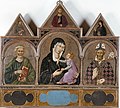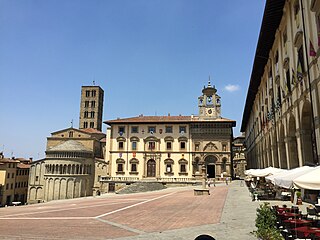
Arezzo is a city and comune in Italy and the capital of the province of the same name located in Tuscany. Arezzo is about 80 kilometres southeast of Florence at an elevation of 296 metres (971 ft) above sea level. As of 2022, the population was about 97,000.

Benozzo Gozzoli was an Italian Renaissance painter from Florence. A pupil of Fra Angelico, Gozzoli is best known for a series of murals in the Magi Chapel of the Palazzo Medici-Riccardi, depicting festive, vibrant processions with fine attention to detail and a pronounced International Gothic influence. The chapel's fresco cycle reveals a new Renaissance interest in nature with its realistic depiction of landscapes and vivid human portraits. Gozzoli is considered one of the most prolific fresco painters of his generation. While he was mainly active in Tuscany, he also worked in Umbria and Rome.

Calenzano is a comune (municipality) in the Metropolitan City of Florence in the Italian region Tuscany, located about 11 kilometres (7 mi) northwest of Florence. As of 31 December 2004, it had a population of 15,557 and an area of 76.9 square kilometres (29.7 sq mi).

Castelfiorentino is a city and comune (municipality) in the Metropolitan City of Florence, Tuscany, central-northern Italy, halfway between Florence, Pisa (45 km) and Siena (55 km). The population is approximately 20,000 inhabitants. It is part of Valdelsa. Castelfiorentino borders the following municipalities: Certaldo, Empoli, Gambassi Terme, Montaione, Montespertoli and San Miniato.

Lorenzo di Niccolò or Lorenzo di Niccolò di Martino was an Italian painter who was active in Florence from 1391 to 1412. This early Renaissance artist worked in the Trecento style, and his work maintains influences of the Gothic style, marking a transitional period between the Gothic sensibilities of the Middle Ages while simultaneously beginning to draw on the Classical. Lorenzo's works were usually religious scenes in tempera with gold backgrounds.
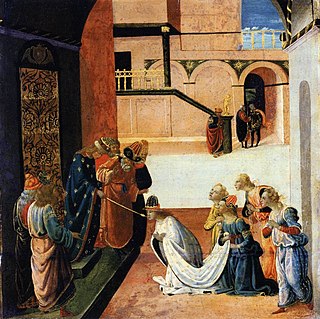
Jacopo del Sellaio (1441/42–1493), was an Italian painter of the early Renaissance, active in his native Florence. His real name was Jacopo di Arcangelo. He worked in an eclectic style based on those of Botticelli, Filippino Lippi, and Domenico Ghirlandaio. The nickname Sellaio derives from the profession of his father, a saddle maker.

Lorenzo di Bicci was an Italian painter of the Florentine School considered to be one of the most important painters in Florence during the second half of the 14th century. He is believed to have learned his trade from his father, about whom little is known. Lorenzo’s style, as well as that of his contemporaries Jacopo di Cione and Niccolò di Pietro Gerini, was influenced by the artist Andrea di Cione. Lorenzo's paintings made use of bright colors and his compositions avoided complexity. The figures he painted tended to have round faces and were often expressionless. Another one of Lorenzo's distinctive characteristics was his precision of execution. He was known for exceptional talent in drawing, an ability that he put to use at the initial stages of his painting. Unlike many celebrated Florentine artists of this period, Lorenzo mostly received commissions from the country clergy and from the lower-middle-class Florentine guilds. His successors, Bicci di Lorenzo and Neri di Bicci, continued to serve these groups.

Bastiano di Bartolo Mainardi (1466–1513) was an Italian painter of the Early Renaissance. He was born in San Gimignano and was active there and in Florence.

Pistoia Cathedral, or Cathedral of Saint Zeno is the main religious building of Pistoia, Tuscany, central Italy, located in the Piazza del Duomo in the centre of the city. It is the seat of the Bishop of Pistoia and is dedicated to Saint Zeno of Verona.

Raffaello Botticini was an Italian Renaissance painter active in Florence and its environs.
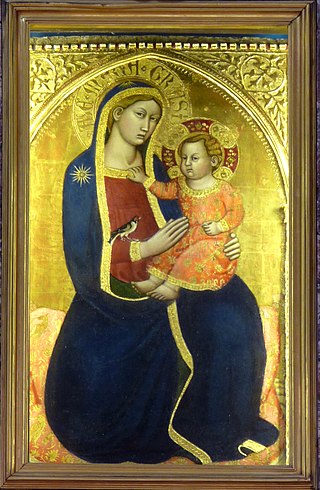
Jacopo di Michele, also called Jacopo Gera, Iacopo di Michele, or Gera da Pisa is a 14th-century painter, active mainly in Pisa and elsewhere in Tuscany, in a Gothic style. His activity is documented from 1361 to 1395. He is the brother of Getto di Jacopo

San Donnino is a Romanesque-style, Roman Catholic pieve church located in the frazione of Villamagna, in the territory of the commune of Bagno a Ripoli in the metropolitan city of Florence, region of Tuscany, Italy. The church was founded in the 8th century and rebuilt prior to the 14th century.

The Museo d'Arte Sacra della Val d'Arbia is a small museum of religious art in Buonconvento, in the Val d'Arbia to the south of Siena, in Tuscany in central Italy. It contain a number of paintings by important artists of the Sienese School, among them Duccio di Buoninsegna, Sano di Pietro and Pietro Lorenzetti. The museum is housed in the Palazzo Ricci Socini, close to the parish church of Santi Pietro e Paolo.
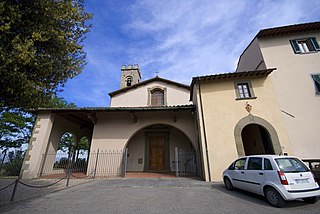
San Martino a Gangalandi is a Roman Catholic parish (pieve) church in the Gangalandi neighborhood of Lastra a Signa in the region of Tuscany, Italy. It is located via Leon Battista Alberti. Adjacent to the church is a small Museo Vicariale displaying some works of art.

Sant'Andrea a San Donnino is a Roman Catholic parish church in the San Donnino neighborhood of the town limits of Campi Bisenzio, located on the Via Pistoiese just west of Florence, in the region of Tuscany, Italy. Adjacent to the church is a small art Museum.
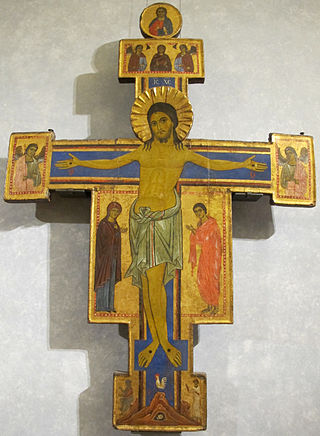
The Master of the Bigallo Crucifix or Bigallo Master was an Italian painter active around Florence in the first half of the 13th century. He ran one of the first fully organized workshops before Cimabue, specializing in large painted crucifixes for churches, one of the main formats for panel paintings at the time. His notname comes from one of these in the Museo del Bigallo in Florence. A similar work is in the Palazzo Barberini site of the Galleria Nazionale d'Arte Antica museum, Rome.
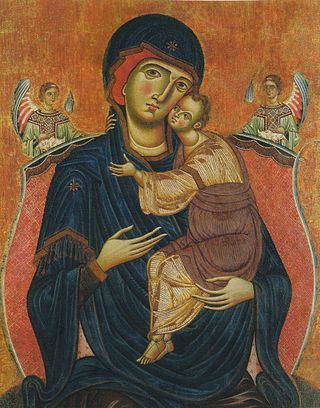
Meliore di Jacopo was a Medieval Italian painter from Florence.



